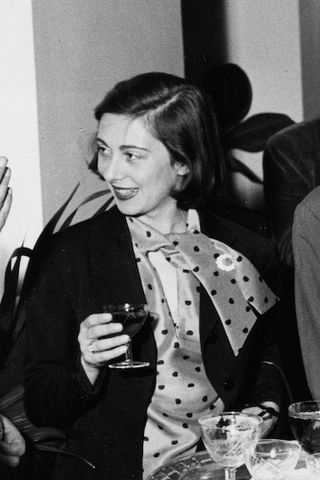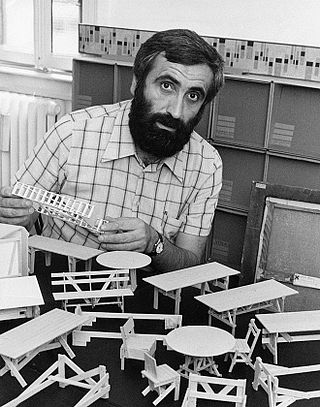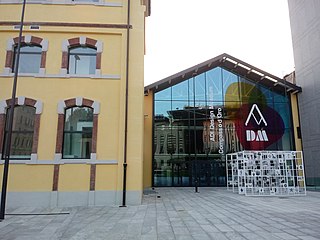
Issey Miyake was a Japanese fashion designer. He was known for his technology-driven clothing designs, exhibitions and fragrances, such as L'eau d'Issey, which became his best-known product.

Ettore Sottsass was a 20th-century Italian architect, noted for also designing furniture, jewellery, glass, lighting, home and office wares, as well as numerous buildings and interiors — often defined by bold colours.

The Sacco chair, also known as a bean bag chair,beanbag chair, or simply a beanbag, is a large fabric bag, filled with polystyrene beans, designed by Piero Gatti, Cesare Paolini and Franco Teodoro in 1968. The product is an example of an anatomic chair, as the shape of the object is set by the user. “[The Sacco] became one of the icons of the Italian anti-design movement. Its complete flexibility and formlessness made it the perfect antidote to the static formalism of mainstream Italian furniture of the period,” as Penny Spark wrote in Italian Design – 1870 to the Present.

The Compasso d'Oro is an industrial design award originated in Italy in 1954. Initially sponsored by the La Rinascente, a Milanese department store, the award has been organised and managed by the Associazione per il Disegno Industriale (ADI) since 1964. The Compasso d'Oro is the first, and among the most recognized and respected design awards. It aims to acknowledge and promote quality in its field in Italy and internationally, and has been called both the "Nobel" and the "Oscar" of design.

Achille Castiglioni was an Italian architect and designer of furniture, lighting, radiograms and other objects. As a professor of design, he advised his students "If you are not curious, forget it. If you are not interested in others, what they do and how they act, then being a designer is not the right job for you."

Vico Magistretti was an Italian architect who was also active as an industrial designer, furniture designer, and academic. As a collaborator of humanist architect Ernesto Nathan Rogers, one of Magistretti's first projects was the "poetic" round church in the experimental Milan neighbourhood of QT8. He later designed mass-produced appliances, lighting, and furniture for companies such as Cassina S.p.A., Artemide, and Oluce. These designs won several awards, including the Compasso d'Oro and the Gold Medal of the Chartered Society of Industrial Artists & Designers in 1986.

Richard Sapper was a German industrial designer who was based in Milan for much of his career. He is considered to be one of the most influential figures of post-war Italian design. His products typically feature a combination of technical innovation, simplicity of form, and an element of wit and surprise.

Maria Cristina Mariani Dameno, known as "Cini Boeri" was an Italian architect and designer. She was considered "one of the great pioneering women in Italian design and architecture", who was described as a "formidable architect and designer, paragon of Milanese elegance and verve."
Ronan & Erwan Bouroullec are brothers noted for their design work, which has been featured in publications and museums globally — and spans a wide range from tables and chairs to tableware, rugs, textile walls, office furniture, ceramics, art objects and urban projects.

Flavio Manzoni is an Italian architect and automobile designer. He has been the Chief Design Officer at Ferrari since January 2010 and has led the creation of many Ferrari models, including the Ferrari F12berlinetta in collaboration with Pininfarina; the LaFerrari, the brand's first ever hybrid vehicle. In 2014 he was the recipient of the Compasso d'Oro for his work on the F12berlinetta project.

Enzo Mari was an Italian modernist artist and furniture designer who is known to have influenced many generations of industrial designers.

Emilio Ambasz is an Argentinian-US architect and award-winning industrial designer. From 1969 to 1976 he was Curator of Design at the Museum of Modern Art, in New York. Ambasz has been labeled as "the father, poet, and prophet" of the green architecture by Japanese architect Tadao Ando.
Clino Trini Castelli is an Italian industrial designer and artist. He has used the concept of "noform" through his work in environmental and industrial design, developed through the application of tools such as Design Primario and CMF design.

Setsu and Shinobu Ito are Japanese designers. Their work is stored as permanent collections in the Modern Art Museums in Munich, Germany and Milan, Italy.
Margherita "Mara" Servetto, is an Italian architect and designer. She is the co-founder of Migliore + Servetto Architects.
Michele de Lucchi is an Italian architect and designer.

Zanotta is an Italian furniture company particularly known for the iconic pieces of Italian design it produced in the 1960s, 70s, and 80s. These include the "Sacco" bean bag chair and "Blow", the first mass-produced inflatable chair. The company was founded in 1954 and has its main plant in Nova Milanese. In 1984 Zanotta established its experimental division, Zabro, headed by Alessandro Guerriero, with Alessandro Mendini and Stefano Casciani. Since the death of its founder, Aurelio Zanotta, in 1991, it has been run by members of his family. Zanotta's products were awarded the Compasso d'Oro in 1967, 1979, 1987 and 2020.

Sergio Asti was an Italian designer and architect, primarily known for his industrial designs for firms such as Artemide, Brionvega, FontanaArte, Gabbianelli, Heller, Knoll, Salviati, and Zanotta.

Andrea Branzi was an Italian architect, designer, and academic. He was born and raised in Florence, though he lived and worked in Milan for much of his career. He was a professor and chairman of the School of Interior Design at the Polytechnic University of Milan until 2009.

The ADI Design Museum is a museum in Milan, Italy, which houses the historical collection of the ADI Compasso d'Oro Foundation, as well as temporary exhibitions, public talks and initiatives. It is dedicated to the understanding and promotion of design in Italy and abroad.















